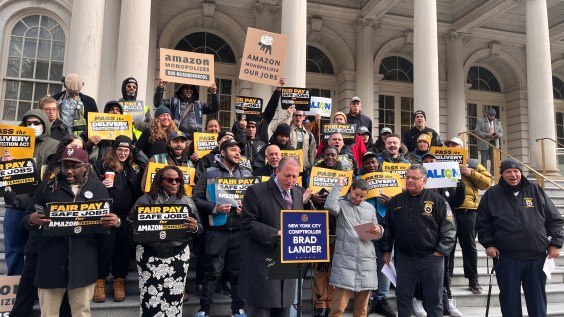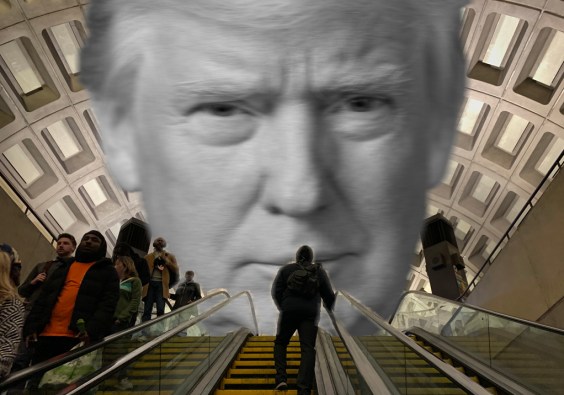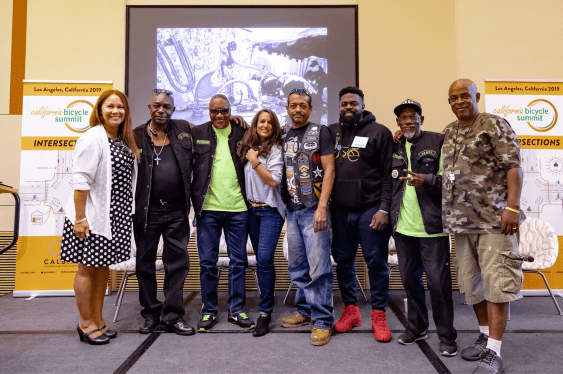This is the third and final installment of our exit interview with departing U.S. Secretary of Transportation Ray LaHood. In the first, he talked about his proudest accomplishments, why he decided to leave, and why it’s important to fund bike/ped improvements with federal dollars – and he made it clear he’s still not giving us any answers about where to find more money for transportation. In the second, he talked about Republicans who get it, why TIGER was a game-changer – and he let slip some good news about the Chicago Riverwalk. Part three is more of a grab-bag -- I hadn’t expected to get almost 40 minutes one-on-one with the secretary!
Tanya Snyder: You mentioned high-speed rail. In California, the line is going to cost upwards of $68 billion. The federal government has put in about three and the funding is still a big question mark there. Do you think that, in the future, going forward with the high-speed rail program, it would make sense to pick sites where the federal government could put in a more substantial proportion of the final funding?
Ray LaHood: High-speed rail is not going to be accomplished by the federal government putting an enormous amount of money in. The money is just not here. And so what we have done is we jump-started passenger rail in America and asked private businesses to come in and make a commitment, to make an investment.
I traveled to 16 or 18 countries in the first two years in this job, looking at high-speed rail. And every place that I went, I asked people come to America, make an investment, hire American workers, and build these trains in America. And now there are a lot of companies in California, in Illinois, along the Northeast Corridor, in Nevada, thinking about making investments.
We’re not going to accomplish our passenger rail, our high-speed rail dreams and aspirations with funding coming from Washington. Some of it can. But the lion’s share will have to be private investment and the states’ commitment to this.
In California, the assembly there passed last year the selling of bonds, between $6 billion and $10 billion worth of bonds. That’s a huge investment. In Illinois, the governor there has made huge investments in high-speed rail. We’ve made some, but he’s made some, and private companies have made some. This is going to have to be a true public-private partnership in order to get this accomplished, and frankly, that’s what happened in Europe and Asia, too.
TS: There was an Anderson Cooper segment a couple weeks ago that underlined for me the fact that maybe the message really hasn’t gotten out about higher-speed rail -- that that was part of this package too. It’s not just about getting trains over 110 mph but it’s also about getting trains that have been going 30 mph up to 70 mph. Do you feel like that’s a message that hasn’t really come across? That people see "high-speed rail" and think it should be going 220?
RL: When you do something big and something new, you’re going to have detractors. And I’ve said all along we are not going to be dissuaded by our detractors. People who don’t want passenger rail and don’t like high-speed rail are going to find something wrong with it. We are going to have trains going 200 mph in California. That’s pretty fast! That’s faster than any other train in America and faster than any other train in California.
The idea that we’re building slow trains is baloney.
So the idea that we haven’t found places where trains are going to go fast is not accurate. In Illinois, our trains are going to be going from 79 mph to 110 mph. [FRA Administrator] Joe [Szabo] and I just rode on a train that went 110 mph because of our investments.
Are we ever going to get trains to go a little faster on the NEC? They’re going to go a little faster. Are they going to go 200 mph? No, because they were built 100 years ago and they’re shoehorned between all these communities. So, in places where we can build new infrastructure – i.e., California -- trains are going to go 200 mph.
The idea that we’re building slow trains is baloney. It’s not true anywhere. Our investments will get trains to go to higher speeds. In Illinois, from 79 to 110. On the Northeast Corridor, a little bit faster. In California, from nothing to 200 mph. It doesn’t get any better than that.
TS: Switching track a little bit, you mentioned recently that you think by 2025 everybody’s going to be driving hybrid and electric cars --
RL: What I said is that because we’ve set CAFE standards at 54.4 mpg by 2025, I think every family will have some form of a hybrid, either all battery powered or a hybrid. That’s just the way America’s going -- and that’s the way the car manufacturers are going.
You look at the Ford products now; just about everything they’re doing is either hybrid or all battery powered. Every car manufacturer is doing that. So I don’t think I’m too far off on that. Most families now have two or three cars. In 2025, most families will at least have two cars. I think one of them will be a hybrid or all battery powered.
TS: Something that we look at a lot at Streetsblog is the fact that emissions are one major, major problem that cars present, but there are others. There’s the fact that you’d need to build a lot more roads; there’s the problem of congestion. Even if every car in America were an electric car, would you still make the argument that we need to wean ourselves off the single-occupancy vehicle?
RL: Absolutely! Yeah, of course. And I think most people get that now. I really do.
TS: That it ‘s not just about emissions?
RL: No, it’s not just about emissions. Look, I think people are going to be driven to this by their pocketbook. Gasoline prices are going to go up. The car manufacturers are going to be manufacturing more hybrids, battery powered [cars]. Just about every road that’s being built now has HOV lanes and that sort of thing. All these sort of things are going to come together at the right time, I think.
We have always, until more recently, been number one because we had a good strong national transportation policy -- and we funded it.
TS: The first $2 billion of the Sandy supplemental has been distributed. Looking at a disaster like that, what do you think communities and transit systems need to do to adapt to climate change?
RL: Build whatever you’re going to rebuild to standards that will be resiliency standards. Do not rebuild this infrastructure to 19th century standards or 20th century standards. They have to be to standards to withstand a Sandy. And we’re going to require that.
We were able to get resiliency money in the bill, thanks to Rodney Frelinghuysen and others.
We know that climate change is going to continue to wreak havoc when these storms hit, and transportation infrastructure has to be built to standards that can withstand these kinds of storms.
TS: So you’re saying there are going to be federal regulations on this?
RL: What I’m saying is, we’re not going to let communities or transit systems rebuild their systems the way they were once built. We’re not going to allow that.
They get that though.
TS: The FRA gets a lot of heat for excessive regulation, safety regulation. Why has that not been addressed?
RL: Safety is our number one priority. Our colleagues at the FRA really believe in this. They believe that implementing good safety regulations is our number one priority. That’s what we should be doing.
TS: Do you think some of it is excessive or --?
RL: Absolutely not. I don’t know how you can be excessive when it comes to safety. You can’t be.
TS: Things like heavier rail cars and locomotives, made heavier to be safer but then they can’t be fuel-efficient; they can’t be fast.
RL: Well look, we’re not going to compromise safety. We’re going to set the highest safety standards possible.
TS: Bill Shuster is the new chair of the T&I Committee. The first hearing he’s holding is a vocal defense of the federal role in transportation and infrastructure spending. There’s a lot of opposition in the Republican party especially, but in general, for a strong role for the federal government. Why do you think the federal government has a strong role to play in transportation, rather than just letting the states do their thing with their money?
RL: Because we should have a national transportation policy, and that can be set by allocation of dollars and priorities. We’ve always done it that way. We have always, until more recently, been number one because we had a good strong national transportation policy -- and we funded it.
That’s what we need to get back to. But it can’t be single-minded or single-issue. It has to be very comprehensive and it has to incorporate what communities really need. The reason that we built the interstate system is because we were committed to doing that. But now that we’ve built it, we need to move on and have a comprehensive, big vision about transportation. We can set that with our partners around the country.
TS: And in setting that policy, what do you feel like the next bill after MAP-21 has to include? What’s the next step? MAP-21 achieved a lot of goals the department had but not all of them. What’s the thing that the next bill really has to do?
RL: A multi-year, comprehensive, creative bill that incorporates what people around the country are really thinking now. And people around the country, as I said, in some instances are way ahead of their politicians. They’re thinking multimodal; they’re thinking many different transportation options; they’re thinking that we should have a national agenda to create the kind of communities where people have many different forms of transportation.





